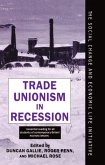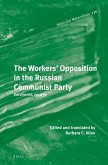- Gebundenes Buch
- Merkliste
- Auf die Merkliste
- Bewerten Bewerten
- Teilen
- Produkt teilen
- Produkterinnerung
- Produkterinnerung
Rhacel Salazar Parre¿as is Professor of Sociology and Gender Studies at the University of Southern California. She is the author of Illicit Flirtations: Labor, Migration, and Sex Trafficking in Tokyo (Stanford, 2011) and Children of Global Migration: Transnational Families and Gendered Woes (Stanford, 2005).
Andere Kunden interessierten sich auch für
![Out to Work Out to Work]() Arianne M GaetanoOut to Work69,99 €
Arianne M GaetanoOut to Work69,99 €![Trade Unionism in Recession Trade Unionism in Recession]() Penn Rose GallieTrade Unionism in Recession181,99 €
Penn Rose GallieTrade Unionism in Recession181,99 €![Dangerous Anarchist Strikers Dangerous Anarchist Strikers]() Steve J ShoneDangerous Anarchist Strikers217,99 €
Steve J ShoneDangerous Anarchist Strikers217,99 €![The Workers' Opposition in the Russian Communist Party The Workers' Opposition in the Russian Communist Party]() The Workers' Opposition in the Russian Communist Party357,99 €
The Workers' Opposition in the Russian Communist Party357,99 €![Pension Power Pension Power]() Isla CarmichaelPension Power93,99 €
Isla CarmichaelPension Power93,99 €![The Brave New World of Work The Brave New World of Work]() Ulrich BeckThe Brave New World of Work37,99 €
Ulrich BeckThe Brave New World of Work37,99 €![The Paradox of American Unionism The Paradox of American Unionism]() Seymour Martin LipsetThe Paradox of American Unionism52,99 €
Seymour Martin LipsetThe Paradox of American Unionism52,99 €-
-
-
Rhacel Salazar Parre¿as is Professor of Sociology and Gender Studies at the University of Southern California. She is the author of Illicit Flirtations: Labor, Migration, and Sex Trafficking in Tokyo (Stanford, 2011) and Children of Global Migration: Transnational Families and Gendered Woes (Stanford, 2005).
Hinweis: Dieser Artikel kann nur an eine deutsche Lieferadresse ausgeliefert werden.
Hinweis: Dieser Artikel kann nur an eine deutsche Lieferadresse ausgeliefert werden.
Produktdetails
- Produktdetails
- Verlag: Stanford University Press
- 2nd edition
- Seitenzahl: 256
- Erscheinungstermin: 26. August 2015
- Englisch
- Abmessung: 236mm x 156mm x 22mm
- Gewicht: 460g
- ISBN-13: 9780804791519
- ISBN-10: 0804791511
- Artikelnr.: 42795757
- Herstellerkennzeichnung
- Libri GmbH
- Europaallee 1
- 36244 Bad Hersfeld
- 06621 890
- Verlag: Stanford University Press
- 2nd edition
- Seitenzahl: 256
- Erscheinungstermin: 26. August 2015
- Englisch
- Abmessung: 236mm x 156mm x 22mm
- Gewicht: 460g
- ISBN-13: 9780804791519
- ISBN-10: 0804791511
- Artikelnr.: 42795757
- Herstellerkennzeichnung
- Libri GmbH
- Europaallee 1
- 36244 Bad Hersfeld
- 06621 890
Rhacel Salazar Parreñas is Professor of Sociology and Gender Studies at the University of Southern California. She is the author of Illicit Flirtations: Labor, Migration, and Sex Trafficking in Tokyo (Stanford, 2011) and Children of Global Migration: Transnational Families and Gendered Woes (Stanford, 2005).
Contents and Abstracts
1The Global Migration of Filipino Domestic Workers
chapter abstract
The chapter provides an overview of the migration of domestic workers from
the Philippines. It describes the paths of migration for Filipino domestic
workers-direct, serial and step-wise. It examines the state-construction of
Filipino domestic workers, introducing the concept of partial citizenship,
which refers to the absence of full citizenship rights allotted to migrant
domestic workers at both ends of the migration spectrum.
2The International Division of Reproductive Labor
chapter abstract
The chapter revisits the concept of the "international division of
reproductive labor," which is also known in the literature as the "care
chain." This concept refers to the transfer of caretaking responsibilities
among women who outsource care to other women in order to participate in
the labor market. Participants in this transfer of care work usually
include the professional woman who hires a migrant domestic worker to care
for her family, while that domestic worker in turn relies on or hires a
woman left behind in the Philippines to care for her family.
3The Transnational Family
chapter abstract
This chapter describes how the transnational family is the most common
household arrangement among migrant domestic workers. By this is meant that
they are part of a family whose members are located in at least two
countries. Although not occupying the same residence, family members in
transnational households share resources, maintain a sense of collective
responsibility for each other's well-being, and uphold the duties expected
of them as kin. Three kinds of transnational families are described:
one-parent, two-parent, and adult children transnational families. The
chapter describes how the transnational family lends itself to the
experience of the pain of family separation.
4Gender and Intergenerational Relations
chapter abstract
This chapter describes the pain of family separation. It argues that the
gender ideology of the feminization of domesticity aggravates the emotional
difficulties faced by the children of migrant mothers in transnational
families. It establishes the difficulty that children face in accepting the
reconstitution of the gender division of labor instigated by women's
migration, as they still expect that their mothers should nurture them in
proximity and not from a distance.
5Contradictory Class Mobility
chapter abstract
This chapter examines the experience of doing domestic work. It shows that
migrant domestic workers face contradictory class mobility, as doing
domestic work involves their downward mobility in status but upward
mobility in earnings. Domestic workers ease the emotional toll of
contradictory class mobility by establishing intimate relations of being
"like a family" with employers.
6The Crisis of Masculinity
chapter abstract
This chapter addresses the question of what happens to men if they find
themselves racially segregated into domestic work. It shows that men
experience the precariousness of labor and suffer from chronic
unemployment. This leaves them in a position of dependency vis-à-vis the
women in the community, challenging the traditional division of labor in
the family. Men respond to this threat to their masculinity via their
engagement in community groups such as the Guardians Brotherhood.
7The Aging of Migrant Domestic Workers
chapter abstract
This chapter uses a survey and interviews to examine what happens to
domestic workers when they age. It establishes the precariousness of
retirement to be due not only to their low wages but also to the informal
nature of the job. It shows that migrant domestic workers who are unable to
retire transition to elder care work in old age, resulting in the
phenomenon of the elderly caring for the elderly. This new form of
inequality shows that the ability of one group to retire is dependent on
the inability of another group to retire.
8Conclusion
chapter abstract
This chapter summarizes the arguments of the book and offers new directions
for the study of migrant domestic work. It specifically calls for more
studies that link the microexamination of domestic work to macrostructures
in society.
1The Global Migration of Filipino Domestic Workers
chapter abstract
The chapter provides an overview of the migration of domestic workers from
the Philippines. It describes the paths of migration for Filipino domestic
workers-direct, serial and step-wise. It examines the state-construction of
Filipino domestic workers, introducing the concept of partial citizenship,
which refers to the absence of full citizenship rights allotted to migrant
domestic workers at both ends of the migration spectrum.
2The International Division of Reproductive Labor
chapter abstract
The chapter revisits the concept of the "international division of
reproductive labor," which is also known in the literature as the "care
chain." This concept refers to the transfer of caretaking responsibilities
among women who outsource care to other women in order to participate in
the labor market. Participants in this transfer of care work usually
include the professional woman who hires a migrant domestic worker to care
for her family, while that domestic worker in turn relies on or hires a
woman left behind in the Philippines to care for her family.
3The Transnational Family
chapter abstract
This chapter describes how the transnational family is the most common
household arrangement among migrant domestic workers. By this is meant that
they are part of a family whose members are located in at least two
countries. Although not occupying the same residence, family members in
transnational households share resources, maintain a sense of collective
responsibility for each other's well-being, and uphold the duties expected
of them as kin. Three kinds of transnational families are described:
one-parent, two-parent, and adult children transnational families. The
chapter describes how the transnational family lends itself to the
experience of the pain of family separation.
4Gender and Intergenerational Relations
chapter abstract
This chapter describes the pain of family separation. It argues that the
gender ideology of the feminization of domesticity aggravates the emotional
difficulties faced by the children of migrant mothers in transnational
families. It establishes the difficulty that children face in accepting the
reconstitution of the gender division of labor instigated by women's
migration, as they still expect that their mothers should nurture them in
proximity and not from a distance.
5Contradictory Class Mobility
chapter abstract
This chapter examines the experience of doing domestic work. It shows that
migrant domestic workers face contradictory class mobility, as doing
domestic work involves their downward mobility in status but upward
mobility in earnings. Domestic workers ease the emotional toll of
contradictory class mobility by establishing intimate relations of being
"like a family" with employers.
6The Crisis of Masculinity
chapter abstract
This chapter addresses the question of what happens to men if they find
themselves racially segregated into domestic work. It shows that men
experience the precariousness of labor and suffer from chronic
unemployment. This leaves them in a position of dependency vis-à-vis the
women in the community, challenging the traditional division of labor in
the family. Men respond to this threat to their masculinity via their
engagement in community groups such as the Guardians Brotherhood.
7The Aging of Migrant Domestic Workers
chapter abstract
This chapter uses a survey and interviews to examine what happens to
domestic workers when they age. It establishes the precariousness of
retirement to be due not only to their low wages but also to the informal
nature of the job. It shows that migrant domestic workers who are unable to
retire transition to elder care work in old age, resulting in the
phenomenon of the elderly caring for the elderly. This new form of
inequality shows that the ability of one group to retire is dependent on
the inability of another group to retire.
8Conclusion
chapter abstract
This chapter summarizes the arguments of the book and offers new directions
for the study of migrant domestic work. It specifically calls for more
studies that link the microexamination of domestic work to macrostructures
in society.
Contents and Abstracts
1The Global Migration of Filipino Domestic Workers
chapter abstract
The chapter provides an overview of the migration of domestic workers from
the Philippines. It describes the paths of migration for Filipino domestic
workers-direct, serial and step-wise. It examines the state-construction of
Filipino domestic workers, introducing the concept of partial citizenship,
which refers to the absence of full citizenship rights allotted to migrant
domestic workers at both ends of the migration spectrum.
2The International Division of Reproductive Labor
chapter abstract
The chapter revisits the concept of the "international division of
reproductive labor," which is also known in the literature as the "care
chain." This concept refers to the transfer of caretaking responsibilities
among women who outsource care to other women in order to participate in
the labor market. Participants in this transfer of care work usually
include the professional woman who hires a migrant domestic worker to care
for her family, while that domestic worker in turn relies on or hires a
woman left behind in the Philippines to care for her family.
3The Transnational Family
chapter abstract
This chapter describes how the transnational family is the most common
household arrangement among migrant domestic workers. By this is meant that
they are part of a family whose members are located in at least two
countries. Although not occupying the same residence, family members in
transnational households share resources, maintain a sense of collective
responsibility for each other's well-being, and uphold the duties expected
of them as kin. Three kinds of transnational families are described:
one-parent, two-parent, and adult children transnational families. The
chapter describes how the transnational family lends itself to the
experience of the pain of family separation.
4Gender and Intergenerational Relations
chapter abstract
This chapter describes the pain of family separation. It argues that the
gender ideology of the feminization of domesticity aggravates the emotional
difficulties faced by the children of migrant mothers in transnational
families. It establishes the difficulty that children face in accepting the
reconstitution of the gender division of labor instigated by women's
migration, as they still expect that their mothers should nurture them in
proximity and not from a distance.
5Contradictory Class Mobility
chapter abstract
This chapter examines the experience of doing domestic work. It shows that
migrant domestic workers face contradictory class mobility, as doing
domestic work involves their downward mobility in status but upward
mobility in earnings. Domestic workers ease the emotional toll of
contradictory class mobility by establishing intimate relations of being
"like a family" with employers.
6The Crisis of Masculinity
chapter abstract
This chapter addresses the question of what happens to men if they find
themselves racially segregated into domestic work. It shows that men
experience the precariousness of labor and suffer from chronic
unemployment. This leaves them in a position of dependency vis-à-vis the
women in the community, challenging the traditional division of labor in
the family. Men respond to this threat to their masculinity via their
engagement in community groups such as the Guardians Brotherhood.
7The Aging of Migrant Domestic Workers
chapter abstract
This chapter uses a survey and interviews to examine what happens to
domestic workers when they age. It establishes the precariousness of
retirement to be due not only to their low wages but also to the informal
nature of the job. It shows that migrant domestic workers who are unable to
retire transition to elder care work in old age, resulting in the
phenomenon of the elderly caring for the elderly. This new form of
inequality shows that the ability of one group to retire is dependent on
the inability of another group to retire.
8Conclusion
chapter abstract
This chapter summarizes the arguments of the book and offers new directions
for the study of migrant domestic work. It specifically calls for more
studies that link the microexamination of domestic work to macrostructures
in society.
1The Global Migration of Filipino Domestic Workers
chapter abstract
The chapter provides an overview of the migration of domestic workers from
the Philippines. It describes the paths of migration for Filipino domestic
workers-direct, serial and step-wise. It examines the state-construction of
Filipino domestic workers, introducing the concept of partial citizenship,
which refers to the absence of full citizenship rights allotted to migrant
domestic workers at both ends of the migration spectrum.
2The International Division of Reproductive Labor
chapter abstract
The chapter revisits the concept of the "international division of
reproductive labor," which is also known in the literature as the "care
chain." This concept refers to the transfer of caretaking responsibilities
among women who outsource care to other women in order to participate in
the labor market. Participants in this transfer of care work usually
include the professional woman who hires a migrant domestic worker to care
for her family, while that domestic worker in turn relies on or hires a
woman left behind in the Philippines to care for her family.
3The Transnational Family
chapter abstract
This chapter describes how the transnational family is the most common
household arrangement among migrant domestic workers. By this is meant that
they are part of a family whose members are located in at least two
countries. Although not occupying the same residence, family members in
transnational households share resources, maintain a sense of collective
responsibility for each other's well-being, and uphold the duties expected
of them as kin. Three kinds of transnational families are described:
one-parent, two-parent, and adult children transnational families. The
chapter describes how the transnational family lends itself to the
experience of the pain of family separation.
4Gender and Intergenerational Relations
chapter abstract
This chapter describes the pain of family separation. It argues that the
gender ideology of the feminization of domesticity aggravates the emotional
difficulties faced by the children of migrant mothers in transnational
families. It establishes the difficulty that children face in accepting the
reconstitution of the gender division of labor instigated by women's
migration, as they still expect that their mothers should nurture them in
proximity and not from a distance.
5Contradictory Class Mobility
chapter abstract
This chapter examines the experience of doing domestic work. It shows that
migrant domestic workers face contradictory class mobility, as doing
domestic work involves their downward mobility in status but upward
mobility in earnings. Domestic workers ease the emotional toll of
contradictory class mobility by establishing intimate relations of being
"like a family" with employers.
6The Crisis of Masculinity
chapter abstract
This chapter addresses the question of what happens to men if they find
themselves racially segregated into domestic work. It shows that men
experience the precariousness of labor and suffer from chronic
unemployment. This leaves them in a position of dependency vis-à-vis the
women in the community, challenging the traditional division of labor in
the family. Men respond to this threat to their masculinity via their
engagement in community groups such as the Guardians Brotherhood.
7The Aging of Migrant Domestic Workers
chapter abstract
This chapter uses a survey and interviews to examine what happens to
domestic workers when they age. It establishes the precariousness of
retirement to be due not only to their low wages but also to the informal
nature of the job. It shows that migrant domestic workers who are unable to
retire transition to elder care work in old age, resulting in the
phenomenon of the elderly caring for the elderly. This new form of
inequality shows that the ability of one group to retire is dependent on
the inability of another group to retire.
8Conclusion
chapter abstract
This chapter summarizes the arguments of the book and offers new directions
for the study of migrant domestic work. It specifically calls for more
studies that link the microexamination of domestic work to macrostructures
in society.








